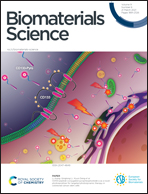‘Golden’ exosomes as delivery vehicles to target tumors and overcome intratumoral barriers: in vivo tracking in a model for head and neck cancer
Abstract
Exosomes are promising vectors for anti-tumor therapy, due to their biocompatibility, low immunogenicity, and innate ability to interact with target cells. However, promoting clinical application of exosome-based therapeutics requires elucidation of key issues, including exosome biodistribution, tumor targeting and accumulation, and the ability to overcome tumor barriers that limit the penetration of various nano-carriers and drugs. Here, we examined these parameters in exosomes derived from mesenchymal stem cells (MSC-exo) and from the A431 squamous cell carcinoma line (A431-exo), which both have potential use in cancer therapy. Using our novel technique combining gold nanoparticle (GNP) labeling of exosomes and non-invasive computed tomography imaging (CT), we longitudinally and quantitatively tracked the two intravenously-injected exosome types in A431 tumor-bearing mice. CT imaging up to 48 h and subsequent ex vivo analysis revealed tumor homing abilities of both exosome types, yet there was significantly higher tumor accumulation of MSC-exo as compared to A431-exo. Moreover, MSC-exo demonstrated the ability to penetrate the tumor and distribute throughout its bulk, while non-encapsulated GNPs remained concentrated at the tumor periphery. Histological analysis showed penetration of MSC-exo not only into the tumor tissue, but also into tumor cell cytoplasm. While the proportion of biodistribution between organs at 48 h was similar for both exosome types, more rapid clearance was indicated for A431-exo. Thus, our findings demonstrate an effect of exosome type on tumor targeting abilities and biodistribution, and suggest that MSC-exo may have superior abilities for tumor-targeted therapy.



 Please wait while we load your content...
Please wait while we load your content...